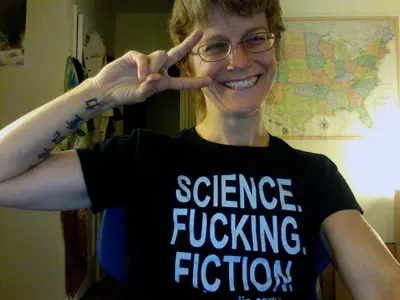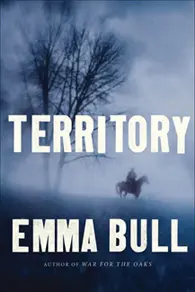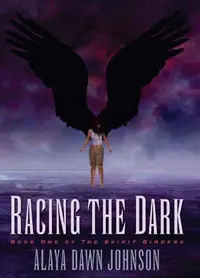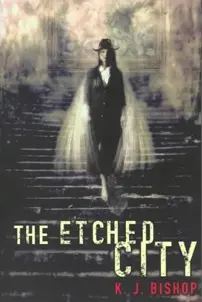I was a bit dismayed after I wrote my column on non-traditional fantasy settings to realize, looking back at it, that there were no women on the list. To be honest, I was thinking of worlds rather than writers, but I don’t want to contribute to any notion that it’s because there aren’t enough women fantasy writers hitting it out of the park. So I thought that I would turn the spotlight onto just that - women fantasy writers who are writing amazing work. This is not meant to be a comprehensive list, of course. These are just five women who deserve to be read, several of whom might be considered under the radar. I’m attempting to rectify that.
Ursula K. LeGuin
If you don’t know the brilliance of Ursula K. LeGuin already, go out and read something of hers right away. She’s a legend in the science fiction and fantasy community and deserves to be.
My favorite of her works are actually science fiction, but her Earthsea books are straight fantasy and have long been favorites for many. What I respect about LeGuin is her choice in writing about brown people. In a time where most fantasy characters were white and of European background, LeGuin chose to make her characters different and later criticized the Sci Fi Channel adaptation’s whitewashing.
The Earthsea stories take place on a vast archipelago and focus on Ged, a young man who discovers that he has magical ability. Of course he must be trained, and so begins a longer story about him coming to terms with his abilities and coming of age. But let LeGuin summarize it, since she does it so much better. From Chapter 1 of A Wizard of Earthsea:
“The Island of Gont, a single mountain that lifts its peak a mile above the storm-racked Northeast Sea, is a land famous for wizards. From the towns in its high valleys and the ports on its dark narrow bays many a Gontishman has gone forth to serve the Lords of the Archipelago in their cities as wizard or mage, or, looking for adventure, to wander working magic from isle to isle of all Earthsea.
“Of these some say the greatest, and surely the greatest voyager, was the man called Sparrowhawk, who in his day became both dragonlord and Archmage. His life is told of in the Deed of Ged and in many songs, but this is a tale of the time before his fame, before the songs were made.
LeGuin is a master writer and the Earthsea series is ranked by many as one of the best fantasy series around. But also, please read her science fiction. The Left Hand of Darkness is brilliant.
![]() Emma Bull
Emma Bull
I am a latecomer to Emma Bull’s writing, but many credit her with the invention of the modern urban fantasy novel. Her first novel, War for the Oaks, was one of the first novels to pair Faeries and Celtic mythic elements with (then) modern day Minneapolis. The result is a wonderful novel that’s as full of music as it is Faeries.
Eddi McCandry is a guitarist in Minneapolis who’s just broken up with her boyfriend and quit her band. To make matters worse, she soon gets dragged into the struggle between the Seelie (good guys) and Unseelie (bad guys) Courts of Faerie. It seems that these kinds of battles require a mortal to add mortality to their battles and Eddi has been chosen. Only if the Unseelie win, Minneapolis will become a much more horrible place. Guarding Eddi is a Phouka who looks like Prince, though his true motives are unclear. Eddi has to try to form her own band while also surviving the very real danger her position puts her into.
"We are of the Seelie Court, noblest blood of Faerie," the glaistig continued. "We are the guardians, the rulers"—here the phouka snorted—"and to us are reserved the sacred grounds of hill and spring, the magical herbs and trees."
"But of course," the phouka broke in, "where there are those who think themselves noble folk, there must be some poor sod to play the commoner. . . ."
"Dog—"
"And in our case, we have the Unseelie Court, the most sodden lot you're like to see."
"Am I ... like to see?" Eddi said weakly.
"Oh, yes. You're certain to, betimes. They've laid claim to territory of ours," he went on, in a voice edged with satire. "We've resolved to water it with their blood."
Bull’s most recent novel, Territory, is more of a Weird Western. Set in Tombstone, Arizona in 1881, it centers on Jesse Fox, a wanderer who comes to town (so many great stories begin that way), and on Mrs. Mildred Benjamin, a writer of fiction who also works at one of the town’s newspapers. But this being Tombstone of that era, the story unfolds against the backdrop of the conflict between the Earps and the Clantons and McLaurys, featuring everyone from Wyatt Earp, his brothers, Bat Masterson and Doc Holliday, to Johnny Ringo and most of Clanton’s associates. Of course since this is a fantasy, there is magic, though it’s rarely called that. Jesse has the gift, though he’s reluctant to use it, but gives in when others begin to misuse their own powers. The showdown at the OK Corral figures into this as you might expect, but even though it’s based on real-life events, there are plenty of surprises. Bull is supposed to be coming out with a sequel soon so now is a great time to check it out.
“Doc Holliday looked down at the wounded boy on top of his cards and tried to think of something else. He clutched at irritation over the spoiled game: now he’d never know if Milt Hicks had had anything when he raised the second time.
He wasn’t drunk enough for dying boys, especially ones he wasn’t responsible for. To have this one land in front of him -- if he signified what Doc suspected he did --- was a foul sort of practical joke.
The fever swelled in his skull, buzzed in his ears. His lungs were like hot lead bars inside his chest -- lead bars you could cough up a piece at a time. He ought to be in bed, not on display in the front window of the Oriental. Damn Morgan for a perfect empty-headed, God-forsaken idiot.
He was lucky it was Frank Leslie tending the Oriental’s bar. Frank did what Wyatt told him to, and Doc, in Wyatt’s absence, could sometimes pass for the voice of Wyatt. He’d bullied Frank into selling him a bottle.
And the cards were good, better than medicine. He’d rather play with clever players, but he’d settle for Ike and Billy Clanton and Milt Hicks. Doc love the cool, relentless logic of the cards. They had no pity or fear or doubt; they fell as they fell, and anyone who regretted or begged them or raged at them was a fool. Sometimes he wished he could be part of the deck. A red jack, maybe, expressionless, with two heads and no ass.
Now here was this corpse, or soon-to-be-corpse, reminding him that flesh was frail and plans were made to totter and fall.”
![]() Alaya Dawn Johnson
Alaya Dawn Johnson
Alaya is younger than a lot of the writers on this list, but she already has four novels to her name as well as numerous short stories in a variety of markets. Alaya’s first two books, Racing the Dark and The Burning City, both deal with a fantasy world set among islands reminiscent of Polynesia. Like LeGuin’s Ged, Lana is a young girl who has power but tries to hide it. When catastrophe strikes, though, she is apprenticed to a witch who demands sacrifices of her. When one of those sacrifices is her mother, Lana must discover how to save her mother’s life, even if that comes at cost to herself.
Alaya has also written two urban fantasy novels set in a 1920s filled with vampires, genies and all kinds of supernatural creatures. Moonshine introduces Zephyr Hollis, a vampire suffragette trying to navigate in a New York stratified not only by race and class, but by species, where alcohol consumption is illegal and where vampires partake in a drug called Faust. Even if you’re experiencing vampire fatigue, Johnson’s writing is confident and riveting and she nails the period feel. The book, and its sequel Wicked City, are also funny and charming and so is Zephyr, our narrator. I’d definitely give these a try if you’re at all interested in urban fantasy.
“My eyes adjusted to the gloom. I could finally see the faint outline of the innocuous little hump that had so firmly caught my attention. It was covered in a child-sized peacoat that smelled of damp wool. Shaking -- because by God there is no way to get used to this, no matter how long I've lived in this city -- I pulled back the cloth. I saw a boy, with hair much redder than my own ochre-tinged brown. His skin was so pale beneath a shock of freckles that i knew what had happened even before I spotted the telltale punctures on his neck.
I sat back on my heels and clenched my teeth. His neck held seven separate wounds -- shallow and rough, as if they'd been teasing him. I'd bet that if I pulled down the collared shirt and suit jacket--finely made, but worn--I'd see more along his back and arms. It looked like some sort of hazing ritual, and maybe a bit of revenge. It looked like the Turn Boys, and was just one more reason for me to despise them. The young vampire gang ran roughshod over their chosen kingdom of Little Italy and the greater Lower East Side. This poor kid was rather far down Lafayette for their activities, but I didn't doubt for a minute who had done this. I'd seen enough of their work to know.”
Finally, I’d also point readers in the direction of Johnson’s short fiction, some of which is available online. My favorite of those I’ve read has to be A Song to Greet the Sun. I should disclose that I’m in a writing group with Alaya, but her work continues to impress and awe me and blow me away on a regular basis. Well worth your time.
![]() K. J. Bishop
K. J. Bishop
K. J. Bishop might be the most obscure name on this list. Bishop is an Australian writer with only one novel under her belt to date, but it’s quite the novel. The Etched City was lumped into the “New Weird” when it came out, alongside writers like Jeff VanderMeer and China Mieville, but here I think it works as a descriptor since the novel has that slightly weird tinge that makes you draw your lips back, but then go back for another taste with a bit more vigor. Bishop’s titular city, Ashamoil, also stands nicely with others like VanderMeer’s Ambergris or Mieville’s New Crobuzon, solid but surreal.
The novel begins almost as a western. Raule and Gwynn are on the run, soldiers from the losing side of a war. Gwynn is a hard man, a gunslinger. Raule is a physician. They travel to Ahsamoil where Gwynn becomes a bodyguard and assassin and Raule spends her time healing those in need. As they ply their trades in Ashamoil, each seemingly inhabiting different poles of life and death, the tale grows and expands almost as a dream might.
Raule crept to the doorway. Squatting, she lifted the bottom edge of the blanket a little and peered into the room. Dark figures lay prone on the floor amid overturned chairs and broken glass. Only the veiled man was standing, wreathed in gunsmoke, lit by a cat’s cradle of thin sunbeams threading through new bullet holes in the walls and roof. He reloaded the pair of long-barrelled revolvers he had in hand and holstered them. Then from the curved scabbard he drew a yataghan, and swung it down three times, severing each fallen man’s head. That had always been his preferred way of making sure of a kill. Raule thought it was something of a comforting habit, too, like some people’s habits of straightening crooked-hanging pictures, or always wearing a certain item of clothing.
She got to her feet. As she went to move the blanket, the wire fell down. The man started, and brought the sword up. Seeing only Raule there, he lowered it again.
Raule stepped inside and took a few paces into the smoke, stopping several feet short of the man and the mire of sawdust and blood he stood in. She glanced down at the bodies. “Who was cheating?”
“Who do you think?” The voice from behind the dustveil was pleasant, with the slightly breathy timbre of a northern accent.
“It seems you’ve still got your sweet touch, Gwynn.”
“You use it or lose it,” he said with a slight shrug. He wiped the sword on the nearest corpse’s sleeve, and sheathed it. He removed his hat, then the domino and veil, disclosing foreign features: a white, finely tapered face, graced by an expression of urbane serenity. His eyes were waterish green, as though they held brine. His long black hair was tied back in a queue. “It’s good to see you, Raule,” he said. Locating an unbroken bottle and glass on the table, he poured himself a drink. “One for yourself?”
“Maybe later.”
When he had quenched his thirst, he stepped over the bodies and held out his hand, smiling. With that smile the strange peace in his looks dissolved, and a baneful quiddity showed itself.
Raule had a moment of hesitation. There were other people she would have preferred to meet. But Gwynn had once been a comrade, and in some ways one of her better friends. She didn’t have so many of those left that she could afford to be choosy. She took his grip.
The Etched City is Bishop's only novel to date, but her website mentions two upcoming novels, so I'm looking forward to getting my hands on those when they come out. In the meantime, if you haven't read The Etched City, go do so.

Kij Johnson
You may have heard of Kij Johnson’s work since so much of it ends up nominated for awards. A good number of those go on to win. This is entirely deserved. Like others on this list, Johnson moves back and forth between science fiction and fantasy, but whatever you’re reading, you always feel like you’re in competent hands. What I admire most about her fiction is that it’s not only well-written, but it always hits me emotionally. Sometimes surprisingly so. As if I get lured in by the engrossing story, and the heart of the story creeps up on me.
To be honest, I haven’t read Johnson’s novels (though I need to rectify that). I have read enough of her short fiction to realize that she’s something special. Her “26 Monkeys, Also the Abyss” is a carefully crafted story where every piece of information falls in exactly the right place. It won the World Fantasy Award and in my opinion deserved to.
Her “Ponies” is a brutal examination of young girls and social hierarchies and fitting in (as well as a dose of commercialism):
“The invitation card has a Western theme. Along its margins, cartoon girls in cowboy hats chase a herd of wild Ponies. The Ponies are no taller than the girls, bright as butterflies, fat, with short round-tipped unicorn horns and small fluffy wings. At the bottom of the card, newly caught Ponies mill about in a corral. The girls have lassoed a pink-and-white Pony. Its eyes and mouth are surprised round Os. There is an exclamation mark over its head.
The little girls are cutting off its horn with curved knives. Its wings are already removed, part of a pile beside the corral.
You and your Pony ___[and Sunny’s name is handwritten here, in puffy letters]___ are invited to a cutting-out party with TheOtherGirls! If we like you, and if your Pony does okay, we’ll let you hang out with us.
Sunny says, “I can’t wait to have friends!” She reads over Barbara’s shoulder, rose-scented breath woofling through Barbara’s hair. They are in the backyard next to Sunny’s pink stable.
Barbara says, “Do you know what you want to keep?”
Sunny’s tiny wings are a blur as she hops into the air, loops, and then hovers, legs curled under her. “Oh, being able to talk, absolutely! Flying is great, but talking is way better!” She drops to the grass. “I don’t know why any Pony would keep her horn! It’s not like it does anything!”
This is the way it’s always been, as long as there have been Ponies. All ponies have wings. All Ponies have horns. All Ponies can talk. Then all Ponies go to a cutting-out party, and they give up two of the three, because that’s what has to happen if a girl is going to fit in with TheOtherGirls. Barbara’s never seen a Pony that still had her horn or wings after her cutting-out party.
Barbara sees TheOtherGirls’ Ponies peeking in the classroom windows just before recess or clustered at the bus stop after school. They’re baby pink and lavender and daffodil-yellow, with flossy manes in ringlets, and tails that curl to the ground. When not at school and cello lessons and ballet class and soccer practice and play group and the orthodontist’s, TheOtherGirls spend their days with their Ponies.”
She is, simply put, one of my favorite writers of short fiction currently. Several of her stories are available online so don’t just take my word for it. Here’s “The Cat Who Walked a Thousand Miles” and “Wife reincarnated as a solitaire—Exposition on the flaws in my spouse's character—The nature of the bird—The possible causes—Her final disposition.”
These are just five amazing writers who also happen to be women, but they’re all worth reading.
Who are some of your favorite female writers?

About the author
Rajan Khanna is a fiction writer, blogger, reviewer and narrator. His first novel, Falling Sky, a post-apocalyptic adventure with airships, is due to be released in October 2014. His short fiction has appeared in Lightspeed Magazine, Beneath Ceaseless Skies, and several anthologies. His articles and reviews have appeared at Tor.com and LitReactor.com and his podcast narrations can be heard at Podcastle, Escape Pod, PseudoPod, Beneath Ceaseless Skies and Lightspeed Magazine. Rajan lives in New York where he's a member of the Altered Fluid writing group. His personal website is www.rajankhanna.com and he tweets, @rajanyk.
 Emma Bull
Emma Bull Alaya Dawn Johnson
Alaya Dawn Johnson K. J. Bishop
K. J. Bishop






